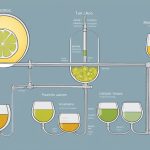Pilsner and lager are two types of beer that are often used interchangeably. However, they have distinct characteristics that set them apart. As a beer enthusiast, I’ve always been intrigued by the differences between pilsner and lager, so I decided to dive deeper into these two styles.
What is Pilsner?
Pilsner is a type of pale lager that originated in the city of Pilsen, Czech Republic, in the mid-19th century. It is known for its light golden color, crisp taste, and floral hop aroma. Pilsner is made using bottom-fermenting yeast, which ferments at cooler temperatures (around 45-55°F or 7-13°C) and results in a clean and smooth flavor profile.
One of the key ingredients in pilsner is Czech Saaz hops, which gives it a distinctive spicy and earthy flavor. Pilsner malt is also used, providing a light, bready sweetness to the beer. The combination of these ingredients creates a balanced and refreshing brew that is perfect for warm summer days.
What is Lager?
Lager is a broad category of beer that includes various styles, including pilsner. Unlike ales, which are top-fermented at higher temperatures, lagers are fermented at cooler temperatures using bottom-fermenting yeast. This results in a slower fermentation process that requires more time for the beer to mature.
While pilsner is a specific type of lager, other lager styles include Munich Helles, Vienna Lager, and Bock. Each of these styles has its own unique flavor profile and characteristics.
How Do They Differ?
While both pilsner and lager are bottom-fermented beers, there are some key differences between the two:
- Pilsner has a lighter color and a crisper, more pronounced hop flavor, whereas other lagers may have a more balanced malt-to-hop ratio.
- Pilsners generally have a higher level of carbonation, which contributes to their refreshing and effervescent quality.
- Pilsners tend to have a slightly higher alcohol content compared to other lagers.
- In terms of taste, pilsners are often described as having a clean and crisp flavor with a noticeable bitterness, whereas other lagers may have a smoother, maltier taste.
My Personal Take
As someone who appreciates the nuances of different beer styles, I must admit that pilsner holds a special place in my heart. I love the bright and refreshing qualities of a well-crafted pilsner, especially on a hot summer day.
There’s something about the combination of the floral hop aroma, the light bready sweetness from the pilsner malt, and the crisp finish that makes pilsner a truly enjoyable beer style. Whether I’m sipping on a Czech Pilsner, a German Pilsner, or even a hop-forward American Pilsner, I can always count on this style to deliver a satisfying drinking experience.
Conclusion
Pilsner and lager may share similarities, but they each have their own unique characteristics that make them distinct. Pilsner’s light golden color, crisp taste, and pronounced hop flavor set it apart from other lagers. So next time you’re in the mood for a refreshing beer, consider trying a pilsner and experience the beauty of this classic style for yourself.







